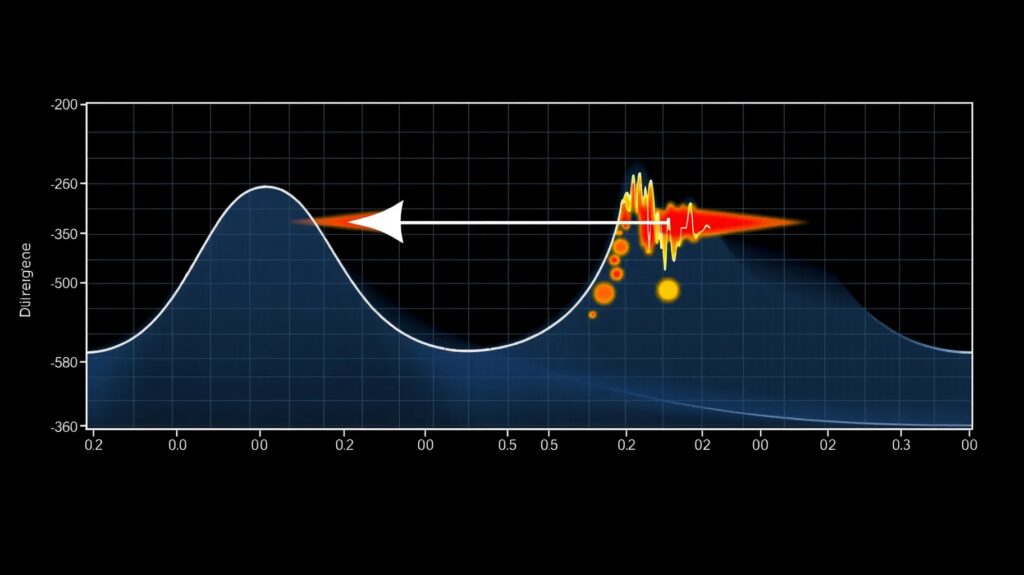
What is Anomaly Detection?
Anomaly detection refers to the process of identifying data points, observations, or patterns that deviate significantly from the normal behavior of a dataset. These outliers may indicate unusual or suspicious activity, such as fraud, system failure, or even cyber-attacks.
In many real-world scenarios, detecting anomalies is critical for maintaining system security, ensuring accurate diagnostics, or identifying financial irregularities.
Anomalies can take many forms—sudden spikes in network traffic, irregular patterns in medical data, or fraudulent transactions in financial datasets.
The challenge in anomaly detection is that these outliers are often rare and scattered among normal instances, making them hard to identify, especially in high-dimensional datasets where patterns can be complex.
How SVMs Excel in High-Dimensional Anomaly Detection
Traditional machine learning algorithms can struggle to handle high-dimensional data effectively, as relationships between features become harder to interpret. This is where Support Vector Machines (SVMs) shine, particularly for anomaly detection.

SVMs work exceptionally well in high-dimensional spaces, where they can capture complex boundaries between normal and abnormal data points. They do this by creating a decision boundary that maximizes the separation between the typical data points and potential outliers.
In high-dimensional data, this decision boundary (or hyperplane) helps ensure that anomalies are correctly identified even when the relationship between variables is nonlinear or difficult to visualize.
SVMs are especially effective for anomaly detection because they maximize the margin around the decision boundary, making it less likely that outliers will be misclassified as normal data. Additionally, SVMs don’t rely on assumptions about the data distribution (e.g., assuming normal distribution), which makes them more flexible for identifying outliers in real-world, high-dimensional datasets.
One-Class SVM: The Tool for Detecting Anomalies
When using SVMs for anomaly detection, the most common approach is the One-Class SVM. Unlike regular SVMs, which are designed for classification tasks (e.g., distinguishing between two classes), One-Class SVM focuses on identifying whether a new observation fits within the “normal” class or is an anomaly.
The idea behind One-Class SVM is simple: it learns the boundary around the normal data points during the training phase, and anything that falls outside this boundary is flagged as an anomaly.
How One-Class SVM Works:
- Training Phase: One-Class SVM is trained using only normal data points. It identifies a region (decision boundary) in the feature space that encapsulates these points, maximizing the margin between the normal data and the boundary.
- Prediction Phase: When new data points are introduced, One-Class SVM predicts whether they fall within the established boundary (normal) or outside (anomalous).
By focusing solely on the normal data, One-Class SVM doesn’t need labeled examples of anomalies during training, making it particularly useful when anomaly data is scarce or unlabeled.
The Math Behind One-Class SVMs
The core of One-Class SVM is based on a decision function that estimates the support of a high-dimensional distribution. Let’s break it down:
- Mapping Data to High-Dimensional Space: Like other SVMs, One-Class SVM uses a kernel function (e.g., radial basis function or polynomial) to map input data into a higher-dimensional space where it becomes easier to define a linear boundary between normal data and potential anomalies.
- Maximizing the Margin: One-Class SVM finds the hyperplane that maximizes the distance between the normal data points and the decision boundary. It does so by solving an optimization problem, minimizing a regularization term while ensuring most data points lie within the boundary.
- Decision Function: The resulting decision function outputs whether new points fall within the learned boundary (normal) or outside it (anomalous). The decision is based on a threshold value, which can be adjusted to control the sensitivity of the anomaly detection.
SVMs and Outlier Detection in Complex Datasets
SVMs are particularly suited for outlier detection in datasets with many features, where relationships between variables are often not linear. Many traditional algorithms can struggle to define meaningful decision boundaries in such scenarios, but SVMs, through the use of the kernel trick, are capable of handling even the most complex patterns.
For example, in a financial dataset where each feature could represent different aspects of a transaction (e.g., location, time, amount, etc.), the relationship between features is complex. Anomalies—like fraudulent transactions—may only become evident when multiple features are considered together. SVMs help identify these anomalies by projecting the data into a higher-dimensional space, making it easier to find decision boundaries that effectively separate outliers from normal data.
Moreover, SVMs are robust to noise and handle imbalanced data well. In real-world datasets, anomalies are typically few, and SVMs focus on maximizing the margin around the normal data, making them less sensitive to individual noisy points that could otherwise distort the boundary.
Real-World Applications of SVM in Anomaly Detection
SVMs are used in a variety of real-world applications for anomaly detection, especially in industries where identifying outliers is critical to security and operational efficiency. Some key use cases include:
- Fraud Detection: Financial institutions use SVMs to spot fraudulent transactions by identifying behaviors that deviate from normal spending patterns, such as sudden large purchases or unusual geographic locations.
- Cybersecurity: In intrusion detection systems, SVMs help detect unusual network traffic patterns that may indicate a cyber-attack or unauthorized access to sensitive systems. By monitoring real-time data flows, SVMs can flag potential threats early.
- Medical Diagnostics: Anomaly detection plays a significant role in healthcare, where detecting abnormal patterns in medical imaging, such as MRIs or CT scans, can indicate the presence of diseases like tumors. SVMs can identify these anomalies even in complex, high-dimensional imaging data.
- Industrial Monitoring: In manufacturing, SVMs can detect machine failures or operational anomalies by continuously monitoring data streams from sensors. When unusual behavior is detected—such as changes in temperature, pressure, or vibration—SVMs can flag these anomalies before they lead to larger problems.
SVM-based anomaly detection is flexible and widely applicable, making it one of the most effective techniques for detecting outliers in complex, high-dimensional datasets.
Why SVMs Work for High-Dimensional Data
One of the biggest advantages of Support Vector Machines (SVMs), particularly for anomaly detection, is their ability to handle high-dimensional data. In many real-world applications, datasets have hundreds or thousands of features, making it difficult to visualize and identify patterns. SVMs, however, are specifically designed to thrive in such environments.
How SVMs Handle High-Dimensionality
- Maximizing the Margin: In high-dimensional spaces, SVMs maximize the margin between normal data points and potential outliers. This margin is critical because it helps the model generalize well, even in complex feature spaces. By focusing on support vectors (the data points closest to the boundary), SVMs identify the most relevant features, effectively ignoring irrelevant noise.
- Kernel Functions: A key feature of SVMs is the kernel trick, which allows the algorithm to find boundaries in high-dimensional spaces without explicitly calculating the transformation of each point. This means that even when relationships between features are complex and nonlinear, SVMs can find the optimal boundary by mapping the data into a higher dimension.
- No Curse of Dimensionality: Unlike many other algorithms, SVMs are relatively unaffected by the curse of dimensionality—the phenomenon where increasing the number of features makes models overfit or perform poorly. SVMs use regularization techniques (like the C parameter) to ensure that even in high-dimensional spaces, the model doesn’t become too specific to the training data, maintaining its ability to generalize.
High-dimensionality is a common challenge in fields like bioinformatics, finance, and text classification, where datasets often contain a vast number of features. SVMs’ resilience in these situations makes them an excellent choice for anomaly detection when the data is complex and multi-dimensional.
Kernel Trick in Anomaly Detection: Finding Patterns in Nonlinear Spaces
Anomalies in datasets often arise from complex, nonlinear relationships between variables, making it difficult to draw straight-line boundaries between normal and abnormal data. This is where the kernel trick shines. SVMs use kernel functions to project data into a higher-dimensional space, where it becomes easier to separate normal data points from anomalies.
Popular Kernel Functions for Anomaly Detection:
- Radial Basis Function (RBF) Kernel: One of the most commonly used kernels in One-Class SVMs, the RBF kernel is ideal for identifying nonlinear boundaries between normal data and outliers. It maps data into a higher-dimensional space, allowing the SVM to draw circular or elliptical boundaries around normal data, capturing outliers that fall outside this region.
- Polynomial Kernel: The polynomial kernel is effective when the relationship between features follows a polynomial pattern. It allows the model to fit more complex decision boundaries, which can be useful when detecting anomalies in datasets where interactions between variables are not linear.
- Sigmoid Kernel: While less common in anomaly detection, the sigmoid kernel (which behaves similarly to neural networks’ activation functions) can also be used to detect subtle non-linear patterns that signal anomalies.
Why the Kernel Trick Matters:
By using the kernel trick, SVMs avoid the computational complexity of explicitly transforming the data into higher dimensions. Instead, the kernel function calculates the distance between data points in this high-dimensional space directly, enabling the algorithm to find optimal boundaries even in nonlinear datasets.
In anomaly detection, where outliers often form complex, hard-to-define patterns, the kernel trick allows SVMs to efficiently detect these points by creating boundaries that capture these irregularities. This makes SVMs one of the most powerful tools for detecting outliers in high-dimensional, nonlinear datasets.

Tuning Hyperparameters for Better Anomaly Detection
Support Vector Machines are highly effective, but their performance in anomaly detection depends heavily on the correct tuning of hyperparameters. In the context of One-Class SVM, two key parameters require special attention: nu (ν) and gamma (γ).
1. Nu (ν) Parameter
The nu (ν) parameter in One-Class SVM represents the fraction of training errors allowed and controls the number of support vectors. In anomaly detection, this parameter determines how tight or loose the boundary around normal data is:
- A low ν value will make the model less sensitive to outliers, potentially ignoring true anomalies.
- A high ν value makes the model more sensitive, but at the risk of labeling normal data points as outliers (increasing false positives).
Tuning nu requires a balance between detecting as many true outliers as possible without introducing too many false positives.
2. Gamma (γ) Parameter
The gamma parameter defines how far the influence of a single training example reaches:
- A low gamma value means that points far from the hyperplane still influence the decision boundary, creating a smoother decision surface.
- A high gamma value restricts the influence of points to their immediate vicinity, making the decision boundary more sensitive to local changes in the dataset.
In anomaly detection, setting gamma too high can make the model overly complex, fitting the noise in the dataset, while a too-low gamma can lead to underfitting, where anomalies aren’t detected effectively.
Tuning Strategy:
- Use grid search to find the optimal combination of nu and gamma. This technique tests multiple values for each parameter, helping you find the best combination for your specific dataset.
- Apply cross-validation to ensure your model generalizes well. Since anomalies are often rare, it’s crucial to test the model’s performance on unseen data to avoid overfitting.
By tuning nu and gamma, you can significantly improve the accuracy and sensitivity of your One-Class SVM for anomaly detection, ensuring it strikes the right balance between catching outliers and minimizing false positives.
SVM vs. Other Anomaly Detection Algorithms
While SVMs are powerful for anomaly detection, it’s important to compare them with other methods to understand when and why they are the best choice. Common alternatives include Isolation Forest, K-means clustering, and Gaussian Mixture Models (GMMs).
1. Isolation Forest:
- How it Works: Isolation Forest isolates anomalies by randomly partitioning data points. Outliers are expected to be isolated faster than normal points due to their rarity.
- Pros: Fast and efficient, especially for large datasets.
- Cons: Less effective in high-dimensional spaces compared to SVMs, and may struggle to detect subtle anomalies that do not form distinct clusters.
2. K-means Clustering:
- How it Works: K-means groups data into clusters, and points that don’t belong to any major cluster are considered anomalies.
- Pros: Simple and easy to implement.
- Cons: Assumes that outliers form separate clusters, which isn’t always true. K-means also struggles with high-dimensional data where clusters aren’t distinct.
3. Gaussian Mixture Models (GMM):
- How it Works: GMM models the data distribution as a mixture of Gaussian distributions, identifying points that deviate from the dominant distribution as anomalies.
- Pros: Works well for data with well-defined distributions.
- Cons: Assumes data follows a Gaussian distribution, which may not always be true in real-world data. SVMs, on the other hand, don’t make such assumptions and are more flexible.
Why SVMs Stand Out:
- SVMs handle high-dimensional data much better than alternatives like K-means and Isolation Forest.
- The kernel trick allows SVMs to model nonlinear relationships between features, making them superior when anomalies don’t follow linear patterns.
- SVMs are robust to noise and imbalanced datasets, making them ideal for anomaly detection in complex, high-dimensional datasets where anomalies are rare.
While Isolation Forest might be faster for large datasets and GMM might be useful for specific types of distributions, SVMs offer the most flexibility and accuracy in high-dimensional, complex datasets.
Handling Imbalanced Datasets in Anomaly Detection
One of the key challenges in anomaly detection is the inherent class imbalance—outliers or anomalies are rare compared to the vast number of normal data points. This imbalance can pose problems for machine learning algorithms that are not designed to handle disproportionate class sizes. Support Vector Machines (SVMs), and in particular One-Class SVM, are well-equipped to manage this imbalance by focusing on distinguishing normal data from everything else.

How SVMs Handle Imbalanced Data:
- Training on One Class: In traditional binary classification problems, you train on two classes. However, for One-Class SVM, you train the model using only the normal data points. This removes the need to rely on a balanced dataset, as the algorithm learns to establish a boundary around normal behavior, and any deviation from this boundary is flagged as anomalous.
- Margin Maximization: SVMs optimize the decision boundary by maximizing the margin between the normal data points and potential anomalies. This characteristic helps mitigate the effects of class imbalance by focusing only on the most critical data points (support vectors) and excluding irrelevant information.
- Robustness to Outliers: By focusing on maximizing the margin and relying on support vectors, SVMs are naturally robust to outliers, even when the dataset contains a significant imbalance. As a result, One-Class SVMs are less likely to misclassify normal data points as anomalies or vice versa.
Data Preprocessing for Imbalanced Datasets
While One-Class SVM inherently addresses imbalance, you can still use various techniques to further optimize performance:
- Resampling: Consider techniques like oversampling the minority class (anomalies) or undersampling the majority class (normal data) to create a more balanced training set.
- Synthetic Data Generation: Use tools like SMOTE (Synthetic Minority Over-sampling Technique) to create artificial samples of anomalies to help the model learn better distinctions between normal and abnormal patterns.
By using SVMs and appropriate data preprocessing techniques, you can effectively handle highly imbalanced datasets, ensuring that even rare outliers are accurately detected.
Challenges of Using SVM for Outlier Detection
Despite the strengths of SVMs in anomaly detection, there are several challenges and limitations to be aware of when applying this technique to outlier detection.
1. Computational Complexity
SVMs can be computationally expensive, especially when dealing with large datasets and high-dimensional spaces. Training SVMs involves solving a quadratic optimization problem, which can scale poorly with large amounts of data. This makes SVMs less ideal for applications where real-time anomaly detection is required or when the dataset is extremely large.
Solution: Use approximate SVMs or online SVMs, which are optimized for faster computation. Additionally, consider dimensionality reduction techniques like PCA to reduce the number of features, speeding up training without sacrificing accuracy.
2. Choice of Kernel Function
Selecting the right kernel function is critical in making sure that the SVM can effectively separate anomalies from normal data. However, the choice of kernel and the associated hyperparameters (such as gamma for RBF kernels) can be challenging to tune, especially when the dataset is complex and contains nonlinear patterns.
Solution: Use grid search and cross-validation to systematically explore different kernel functions and tune hyperparameters. While the RBF kernel is often a good starting point, experimenting with polynomial and sigmoid kernels may lead to better performance depending on the nature of your data.
3. Handling Overfitting
In anomaly detection, especially with imbalanced datasets, overfitting can occur when the model becomes too sensitive to the training data, detecting too many false positives or being too rigid to detect subtle anomalies.
Solution: Tune the C parameter in SVM to control the model’s flexibility. Lowering the C value will make the SVM less strict about misclassifying points near the boundary, reducing overfitting and improving generalization. Regularization methods can also be applied to reduce overfitting.
4. Limited Interpretability
While SVMs are powerful for detecting anomalies, they are often criticized for being black box models, especially when nonlinear kernels are used. It’s challenging to explain how the model arrives at its decision to flag a point as anomalous, which can be problematic in industries where interpretability is crucial (e.g., healthcare, finance).
Solution: Consider linear SVMs or simpler models for scenarios where interpretability is essential. Alternatively, techniques like LIME (Local Interpretable Model-agnostic Explanations) can be applied to provide insights into how the model classifies individual data points.
By addressing these challenges through careful tuning and model selection, you can maximize the effectiveness of SVMs for detecting outliers in complex datasets.

SVMs for Cybersecurity: Spotting Threats with Anomaly Detection
In the world of cybersecurity, anomaly detection is critical for identifying suspicious activity and preventing security breaches. Support Vector Machines (SVMs) have become a powerful tool for intrusion detection systems (IDS) and network traffic analysis, where the goal is to detect unusual patterns that may indicate a cyber attack.
How SVMs Detect Anomalies in Cybersecurity:
- Intrusion Detection: SVMs can analyze network traffic to detect anomalies that suggest potential intrusions or unauthorized access. They do this by establishing a baseline of normal network behavior and flagging any deviations—such as unexpected spikes in traffic, unauthorized access attempts, or unusual data transmission patterns.
- Malware Detection: SVMs can be used to identify malware by analyzing file behaviors and system logs. By training on a dataset of known benign activity, One-Class SVM can detect abnormal file behaviors indicative of malware or other malicious software.
- Real-Time Monitoring: Cybersecurity systems require real-time anomaly detection, and while SVMs can be computationally expensive, advancements in online SVM models allow for continuous monitoring of network traffic or system logs, ensuring that threats are detected as they arise.
Why SVMs are Effective for Cybersecurity:
- Scalability: SVMs scale well to high-dimensional data, which is essential for analyzing network traffic, where each packet or transaction might have dozens or hundreds of features.
- Nonlinear Patterns: Attack patterns are rarely linear, and the kernel trick enables SVMs to capture these complex, nonlinear relationships in the data, making them highly effective for identifying sophisticated threats.
Fraud Detection with SVMs: Identifying Abnormal Transactions
In financial systems, detecting fraudulent activity is one of the highest priorities. SVMs have proven to be highly effective in fraud detection by identifying outlier transactions that deviate from normal behavior patterns.
How SVMs Work in Fraud Detection:
- Transaction Analysis: By analyzing historical transaction data, SVMs establish a model of what constitutes normal behavior for an account or user. One-Class SVMs then flag any transactions that fall outside of this normal range as potential fraud.
- Dynamic Patterns: Fraudulent transactions often involve multiple variables—location, transaction size, frequency—that interact in complex ways. SVMs can model these multidimensional relationships and detect anomalies that simpler models might miss.
Example Applications:
- Credit Card Fraud: SVMs analyze millions of credit card transactions, flagging those that deviate from typical spending patterns (e.g., unusual geographic location, abnormally large purchases).
- Insurance Fraud: In the insurance industry, SVMs detect claims that deviate from normal claim behaviors, helping companies identify fraudulent claims that might otherwise go unnoticed.
By using SVMs for fraud detection, financial institutions can reduce the risk of financial losses and improve security, offering a proactive approach to identifying fraudulent activities in real time.
Anomaly Detection in Medical Diagnostics with SVMs
In medical diagnostics, the ability to identify anomalies is crucial for early disease detection and intervention. SVMs are particularly useful in analyzing medical imaging data and patient records to identify outliers that may indicate underlying health issues.
Medical Applications of SVM Anomaly Detection (continued):
- Medical Imaging: SVMs are widely used to detect abnormalities in CT scans, MRIs, and X-rays. For example, in the early detection of tumors or other irregularities, One-Class SVMs can learn what constitutes a normal scan and flag anything that deviates from this standard as potentially abnormal. By identifying these anomalies, doctors can diagnose conditions like cancer at an earlier stage, improving the chances of successful treatment.
- Genomics and Bioinformatics: SVMs are also applied in the analysis of genomic data to detect irregular gene expressions that may indicate diseases such as cancer or genetic disorders. Anomalies in genetic data often exist within large, complex datasets, making SVMs ideal due to their ability to handle high-dimensional data effectively.
- Patient Records and Diagnostics: SVMs can analyze vast datasets of patient medical histories, identifying patterns or anomalies that may suggest an impending health issue. For example, irregularities in heart rate data, blood pressure trends, or other vital signs can be detected by One-Class SVMs, helping physicians intervene before a critical health event, such as a heart attack or stroke, occurs.
Why SVMs are Effective in Medical Diagnostics:
- High Dimensionality: Medical data is often highly complex, with multiple dimensions (e.g., patient history, lab results, imaging data), making SVMs a perfect fit for detecting outliers in such environments.
- Nonlinear Relationships: In medical diagnostics, relationships between variables (like symptoms and conditions) are often nonlinear. The kernel trick allows SVMs to find patterns in these complex, nonlinear datasets, which might not be obvious with simpler algorithms.
By using SVMs in medical diagnostics, healthcare providers can ensure early and accurate detection of potential health issues, improving patient outcomes and streamlining healthcare processes.

How to Implement One-Class SVMs in Python
Implementing One-Class SVMs in Python is straightforward, thanks to libraries like Scikit-learn, which provide built-in support for SVMs. Here’s a quick guide on how to use One-Class SVM for anomaly detection:
Step 1: Import Necessary Libraries
from sklearn.svm import OneClassSVM
from sklearn.preprocessing import StandardScaler
import numpy as np
Step 2: Load and Preprocess the Data
It’s important to scale the data before applying SVM, especially in high-dimensional datasets.
# Sample dataset (replace with your own data)
data = np.random.rand(100, 2) # 100 data points with 2 features
# Standardizing the data
scaler = StandardScaler()
data_scaled = scaler.fit_transform(data)
Step 3: Train the One-Class SVM
# Train a One-Class SVM model
model = OneClassSVM(kernel='rbf', gamma='auto', nu=0.1) # You can adjust gamma and nu
model.fit(data_scaled)
Step 4: Predict Anomalies
# Predict anomalies (returns 1 for normal data, -1 for anomalies)
predictions = model.predict(data_scaled)
# Count anomalies
anomalies = np.where(predictions == -1)
print(f"Number of anomalies detected: {len(anomalies[0])}")
Step 5: Evaluate and Tune
After implementing One-Class SVM, you can tune the model by adjusting nu (controls the percentage of outliers) and gamma (influences the kernel’s flexibility) to get better results for your specific dataset.
The Future of SVMs in Anomaly Detection: AI and Beyond
While Support Vector Machines (SVMs) have been around for some time, their role in anomaly detection is far from obsolete. In fact, advancements in machine learning and artificial intelligence are likely to enhance how SVMs are used in detecting outliers in the future.
1. Hybrid Models:
As AI continues to evolve, hybrid models combining SVMs with deep learning methods are emerging. For instance, deep learning models can be used for feature extraction in complex data like images or text, and SVMs can then be applied to detect anomalies within these extracted features. This hybrid approach could improve both accuracy and scalability.
2. Online and Incremental Learning:
In fields like cybersecurity or finance, real-time anomaly detection is essential. Online learning methods that allow SVMs to update their models continuously as new data streams in are becoming increasingly popular. These incremental approaches ensure that the SVM remains effective even as patterns in the data evolve over time.
3. Quantum Support Vector Machines (QSVMs):
As quantum computing advances, Quantum SVMs may provide a new frontier for anomaly detection in high-dimensional data. Quantum algorithms have the potential to solve SVM optimization problems much faster, allowing for real-time anomaly detection in massive datasets that are otherwise computationally prohibitive.
Conclusion
Support Vector Machines (SVMs), and particularly One-Class SVMs, are powerful tools for anomaly detection in complex, high-dimensional datasets. Whether you’re working in cybersecurity, finance, healthcare, or industrial monitoring, SVMs provide a robust way to detect outliers and protect systems from potential failures, fraud, or attacks.
By leveraging the kernel trick, margin maximization, and thoughtful hyperparameter tuning, SVMs remain one of the most effective algorithms for detecting subtle, hard-to-spot anomalies. As advancements in AI, online learning, and quantum computing continue, the role of SVMs in anomaly detection will only grow, ensuring they remain relevant in the ever-evolving landscape of machine learning.
FAQs: SVMs for Anomaly Detection in High-Dimensional Data
1. What is anomaly detection?
Anomaly detection is the process of identifying outliers or data points that deviate significantly from the normal pattern in a dataset. These anomalies may indicate unusual, suspicious, or problematic behavior, such as fraud, equipment malfunction, or security breaches.
2. How does an SVM work for anomaly detection?
For anomaly detection, Support Vector Machines (SVMs) use a method called One-Class SVM. This algorithm learns the boundary that encompasses the “normal” data during training. Any new data points that fall outside this boundary are classified as anomalies. One-Class SVM uses support vectors to identify and maximize the margin between normal and abnormal data.
3. What is a One-Class SVM?
A One-Class SVM is a variation of the standard SVM algorithm designed for unsupervised anomaly detection. It is trained using only normal data and identifies outliers (or anomalies) by determining which data points fall outside of the learned boundary. This is particularly useful when labeled data for anomalies is unavailable or rare.
4. Why are SVMs effective for anomaly detection in high-dimensional data?
SVMs are highly effective in high-dimensional spaces because they can model complex, nonlinear relationships between features. Using the kernel trick, SVMs project data into higher dimensions, where anomalies can be more easily separated from normal data. Their ability to handle many features without suffering from the curse of dimensionality makes them ideal for detecting anomalies in large, complex datasets.
5. What is the kernel trick, and why is it important for anomaly detection?
The kernel trick allows SVMs to operate in higher-dimensional spaces without explicitly calculating the transformation for each data point. This is critical for anomaly detection because it helps the model capture complex, nonlinear patterns that separate normal data from anomalies. Popular kernels include the Radial Basis Function (RBF) and polynomial kernels, which help detect intricate anomalies.
6. How does the One-Class SVM handle imbalanced datasets?
In anomaly detection, datasets are typically highly imbalanced, with anomalies being much rarer than normal data points. One-Class SVMs address this by focusing on learning the boundary around normal data, without needing labeled data for the anomalies. This makes the model robust to imbalanced data, as it doesn’t require an equal number of normal and abnormal instances for training.
7. What are the key hyperparameters to tune in One-Class SVM for anomaly detection?
The two most important hyperparameters are:
- Nu (ν): Controls the proportion of support vectors and margin errors. It determines the sensitivity of the model to anomalies.
- Gamma (γ): Defines how far the influence of a single data point reaches, impacting how tight or loose the boundary is. A higher gamma results in a tighter boundary that might overfit the data, while a lower gamma results in a broader boundary.
8. How do I handle overfitting when using SVMs for anomaly detection?
To prevent overfitting, carefully tune the C parameter (in regular SVMs) or nu (in One-Class SVMs). A lower nu allows for a wider margin and reduces the chances of overfitting, while a higher nu makes the model stricter, potentially leading to overfitting. Additionally, using cross-validation and regularization techniques can help reduce overfitting.
9. What are the advantages of using SVMs for anomaly detection over other algorithms?
- High-dimensional data: SVMs excel at handling datasets with many features.
- Nonlinear data: SVMs, via the kernel trick, can identify nonlinear relationships, making them ideal for complex anomaly detection tasks.
- No assumptions about data distribution: Unlike other algorithms, SVMs do not assume a specific distribution (e.g., Gaussian) for normal or abnormal data.
- Robustness to outliers: SVMs focus on support vectors and are less affected by individual noisy data points.
10. How does SVM compare to other anomaly detection methods like Isolation Forest or K-means?
- SVM vs. Isolation Forest: SVMs handle high-dimensional and nonlinear data better, while Isolation Forest is faster for large datasets and can be more efficient when anomalies are isolated.
- SVM vs. K-means: SVMs do not rely on forming clusters, making them more flexible in finding outliers. K-means is simpler but may miss anomalies that don’t form distinct clusters.
- SVM vs. Gaussian Mixture Models (GMMs): GMMs assume a Gaussian distribution, limiting their use in complex datasets. SVMs do not make such assumptions, offering more flexibility.
11. What are common challenges when using SVMs for anomaly detection?
- Computational cost: SVMs can be slow to train on large datasets, especially with nonlinear kernels.
- Kernel selection: Choosing the right kernel (e.g., RBF, polynomial) and tuning its hyperparameters can be tricky.
- Overfitting: Overfitting can occur if the boundary is too tightly fitted to the training data, leading to high false positives in new data.
- Interpretability: SVMs, especially with nonlinear kernels, can be hard to interpret compared to simpler models.
12. Can SVMs be used for real-time anomaly detection?
Yes, but standard SVMs can be computationally expensive for real-time tasks. However, online SVMs or incremental SVMs are designed to update the model as new data arrives, making them suitable for real-time anomaly detection in applications like cybersecurity or fraud detection.
13. What industries use SVMs for anomaly detection?
SVMs are used across various industries, including:
- Finance: For fraud detection in credit card transactions and insurance claims.
- Cybersecurity: In intrusion detection systems (IDS) to identify abnormal network activity or potential cyberattacks.
- Healthcare: To detect anomalies in medical imaging and patient records, such as early signs of diseases.
- Manufacturing: For predictive maintenance by detecting abnormal machine behavior that could indicate potential equipment failure.
14. How do I implement One-Class SVM for anomaly detection in Python?
Using Scikit-learn, One-Class SVM is easy to implement. Here’s an outline:
from sklearn.svm import OneClassSVM
from sklearn.preprocessing import StandardScaler
# Load and preprocess your data
data = ... # Load your dataset
scaler = StandardScaler()
data_scaled = scaler.fit_transform(data)
# Train the One-Class SVM model
model = OneClassSVM(kernel='rbf', gamma='auto', nu=0.1)
model.fit(data_scaled)
# Predict anomalies
predictions = model.predict(data_scaled)
Tuning nu and gamma is essential for performance, and using cross-validation can help optimize the model.
15. What are some real-world applications of SVM anomaly detection?
- Fraud detection: Detecting unusual credit card transactions or fraudulent insurance claims.
- Cybersecurity: Identifying abnormal patterns in network traffic that may signal an attack.
- Medical diagnostics: Detecting anomalies in medical scans, such as tumors or other abnormalities.
- Industrial monitoring: Detecting equipment failures by analyzing sensor data for unusual patterns.
Resources
1. Books and Guides
- “An Introduction to Support Vector Machines and Other Kernel-Based Learning Methods” by Nello Cristianini and John Shawe-Taylor
A foundational book on Support Vector Machines (SVMs) and their application in machine learning, covering both theory and practical aspects. It’s a great resource if you want to dive deeper into the mathematics behind SVMs. - “Pattern Recognition and Machine Learning” by Christopher Bishop
This book provides a comprehensive overview of machine learning algorithms, including SVMs and their use in tasks like anomaly detection. It also covers the theory behind SVMs and various kernel methods. - “Machine Learning for Cybersecurity: A Comprehensive Guide” by Paulo Shakarian
Focused on cybersecurity, this book covers how SVMs and other machine learning techniques are used to detect anomalies in network traffic and prevent attacks.
2. Online Tutorials
- Scikit-learn Documentation: One-Class SVM
A practical guide that walks you through using One-Class SVM for anomaly detection in Python. Includes code examples and explanations on how to tune hyperparameters like nu and gamma. - “One-Class SVM for Anomaly Detection” (Towards Data Science)
This article explains One-Class SVMs with easy-to-understand examples, including real-world use cases for anomaly detection in high-dimensional data. - “Anomaly Detection with SVMs” (Real Python)
Real Python Guide
A beginner-friendly tutorial that shows you how to implement SVMs in Python for anomaly detection, including data preprocessing steps.
3. Libraries and Tools
- Scikit-learn (Python)
Scikit-learn is one of the most widely-used Python libraries for implementing SVMs. It includes support for One-Class SVM, making it easy to perform anomaly detection in high-dimensional datasets. - LIBSVM
LIBSVM is a popular library for implementing SVMs across various programming languages, including Python, R, and Java. It includes functionality for classification, regression, and One-Class SVM for outlier detection. - TensorFlow
TensorFlow offers tools to implement SVMs and integrate them into deep learning pipelines. It can be useful when creating hybrid models for tasks like anomaly detection in large datasets. - PyTorch
PyTorch is another deep learning library that can be customized to implement SVMs. It’s particularly useful for those building more complex, hybrid anomaly detection systems that combine deep learning and SVM.
4. Research Papers and Case Studies
- “Anomaly Detection using One-Class SVM for Intrusion Detection” by Manevitz and Yousef
Read the paper
This paper presents One-Class SVMs for detecting anomalies, particularly in the context of intrusion detection systems (IDS). It’s an excellent resource for understanding how SVMs can be applied to cybersecurity. - “Support Vector Machines and Anomaly Detection in Finance” by Kweku Amponsah and others
This paper discusses how SVMs are used in fraud detection in finance, explaining the advantages of using One-Class SVMs for identifying anomalies in large financial datasets. - “Anomaly Detection for Healthcare Data Using SVMs” by Singh and Chauhan
This research covers the application of SVMs in detecting anomalies in medical data, particularly in medical imaging and patient records. It explores how SVMs improve diagnostic accuracy and efficiency in healthcare systems. - “A Review of SVM for Outlier Detection in Network Traffic” by Chandola et al.
A comprehensive review of how SVMs are applied in network traffic analysis to detect potential cybersecurity threats through anomaly detection.
5. Video Tutorials
- “Support Vector Machines Explained” (YouTube)
Watch the video
A detailed explanation of how SVMs work, including their mathematical foundation and practical application in anomaly detection. It covers One-Class SVM and its use for detecting outliers. - “One-Class SVM in Python for Anomaly Detection” (YouTube)
A step-by-step coding tutorial for implementing One-Class SVMs using Scikit-learn, covering everything from data preprocessing to tuning hyperparameters. - “Anomaly Detection Using Machine Learning” (YouTube)
A general overview of anomaly detection using various machine learning techniques, including SVMs. This video covers common use cases, like fraud detection and network security.
6. Online Courses and Certifications
- Coursera: “Machine Learning Specialization” by Stanford University
While this course covers a range of machine learning topics, it includes an in-depth section on Support Vector Machines, including their use in anomaly detection. - edX: “Practical Machine Learning” by Johns Hopkins University
This course covers practical aspects of machine learning, including SVMs. It’s particularly focused on real-world applications like detecting outliers in healthcare and finance. - Udemy: “Support Vector Machines in Python”
A hands-on course that walks you through building SVM models from scratch using Python. It includes sections on One-Class SVM and anomaly detection.
7. Open-Source Projects
- PyOD: Python Toolkit for Anomaly Detection
PyOD is a comprehensive Python library for detecting outliers, featuring various algorithms including One-Class SVM. It is widely used for research and commercial applications in cybersecurity, finance, and healthcare anomaly detection tasks. - Anomaly Detection with Scikit-learn (GitHub Project)
View on GitHub
This GitHub project demonstrates how to use Scikit-learn for anomaly detection with One-Class SVM. It includes working code and sample datasets, making it a great starting point for building your own anomaly detection models.





